Related Research Articles
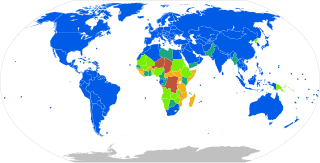
Mains electricity is the general-purpose alternating-current (AC) electric power supply. It is the form of electrical power that is delivered to homes and businesses, and it is the form of electrical power that consumers use when they plug items such as domestic appliances, televisions and electric lamps into wall outlets.

Electric power distribution is the final stage in the delivery of electric power; it carries electricity from the transmission system to individual consumers. Distribution substations connect to the transmission system and lower the transmission voltage to medium voltage ranging between 2 kV and 35 kV with the use of transformers. Primary distribution lines carry this medium voltage power to distribution transformers located near the customer's premises. Distribution transformers again lower the voltage to the utilization voltage used by lighting, industrial equipment or household appliances. Often several customers are supplied from one transformer through secondary distribution lines. Commercial and residential customers are connected to the secondary distribution lines through service drops. Customers demanding a much larger amount of power may be connected directly to the primary distribution level or the subtransmission level.

The electric power industry covers the generation, transmission, distribution and sale of electric power to the general public and industry. The commercial distribution of electric power started in 1882 when electricity was produced for electric lighting. In the 1880s and 1890s, growing economic and safety concerns lead to the regulation of the industry. What was once an expensive novelty limited to the most densely populated areas, reliable and economical electric power has become an essential aspect for normal operation of all elements of developed economies.
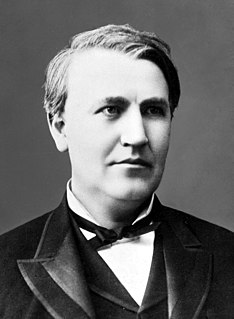
The war of the currents, sometimes called battle of the currents, was a series of events surrounding the introduction of competing electric power transmission systems in the late 1880s and early 1890s. It grew out of two lighting systems developed in the late 1870s and early 1880s; arc lamp street lighting running on high-voltage alternating current (AC), and large-scale low-voltage direct current (DC) indoor incandescent lighting being marketed by Thomas Edison's company. In 1886, the Edison system was faced with new competition: an alternating current system developed by George Westinghouse's company that used transformers to step down from a high voltage so AC could be used for indoor lighting. Using high voltage allowed an AC system to transmit power over longer distances from more efficient large central generating stations. As the use of AC spread rapidly, the Edison Electric Light Company claimed in early 1888 that high voltages used in an alternating current system were hazardous, and that the design was inferior to, and infringed on the patents behind, their direct current system.
Electrification is the process of powering by electricity and, in many contexts, the introduction of such power by changing over from an earlier power source. The broad meaning of the term, such as in the history of technology, economic history, and economic development, usually applies to a region or national economy. Broadly speaking, electrification was the build-out of the electricity generation and electric power distribution systems that occurred in Britain, the United States, and other now-developed countries from the mid-1880s until around 1950 and is still in progress in rural areas in some developing countries. This included the transition in manufacturing from line shaft and belt drive using steam engines and water power to electric motors.

Emera Incorporated is a publicly traded Canadian multinational energy holding company based in Halifax, Nova Scotia. Created in 1998 during the privatization of Nova Scotia Power, a provincial Crown corporation, Emera now invests in regulated electricity generation as well as transmission and distribution across North America and the Caribbean.

Hydro One Limited is an electricity transmission and distribution utility serving the Canadian province of Ontario. Hydro One traces its history to the early 20th century and the establishment of the Hydro-Electric Power Commission of Ontario. In October 1998, the provincial legislature passed the Energy Competition Act which restructured Ontario Hydro into separate entities responsible for electrical generation, transmission/delivery, and price management with a final goal of total privatization.

Trustpower Limited is a New Zealand electricity generation and electricity retailing company, listed on the New Zealand stock exchange.
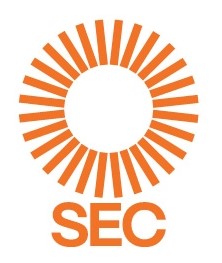
The State Electricity Commission of Victoria is a government-owned electricity supplier in Victoria, Australia. It was set up in 1918, and by 1972 it was the sole agency in the state for electricity generation, transmission, distribution and supply. Control of the SECV was by a Board of Commissioners appointed by the Victorian Government. After 1993, the SECV was disaggregated into generation, transmission and distribution companies, which were further split and then privatised in the mid to late 1990s. However, electricity supply agreements with the Portland and Point Henry aluminium smelters were retained by SECV, which continued as their electricity supplier.
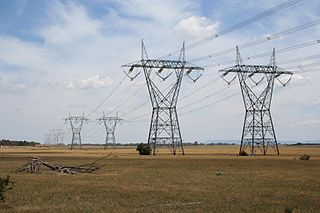
Energy in Victoria, Australia is generated using a number of fuels or technologies, including coal, natural gas and renewable energy sources. Brown coal is the main primary energy source for the generation of electricity in the state, accounting for about 85% of electricity generation in 2008. Brown coal is also one of the largest contributors to Australia's total domestic greenhouse gas emissions and a source of controversy for the country. Australia is one of the highest polluters of greenhouse gas per capita in the world.

Hydro Ottawa is a regulated electricity distribution company operating in the City of Ottawa and the Village of Casselman in Ontario, Canada. As the third-largest municipally owned electrical utility in Ontario, Hydro Ottawa maintains the electricity distribution systems in the province, and serves over 335,000 residential and commercial customers across a service area of 1,100 square kilometres.
The Newcastle and District Electric Lighting Company was a pre-nationalisation, private electricity supply company, based in Newcastle upon Tyne in North East England. The company was set up in 1889 by Charles Algernon Parsons. The company built a number of small coal-fired power stations in the west end of Newcastle upon Tyne, initially to supply homes and streets with electric lighting. They also provided power for an electrified tram line in the western part of the city.

An electrical grid, electric grid or power grid, is an interconnected network for delivering electricity from producers to consumers. It consists of:

Kenya Power and Lighting Company, commonly referred to as Kenya Power or KPLC, is a limited liability company which transmits, distributes and retails electricity to customers throughout Kenya.

Companhia de Electricidade de Macau – CEM, S.A. known simply as CEM or Chinese: 澳電 is a private public utility company with a sole concession to transmit, distribute, sell high, medium and low voltage of electricity in Macau. Besides, CEM owns an installed generation capacity of 408 MW.
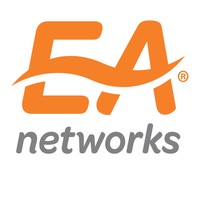
Electricity Ashburton Limited, trading as EA Networks is a co-operatively-owned electricity distribution company, based in Ashburton, New Zealand.
Dhaka Power Distribution Company Limited (DPDC) is a Public Limited Company under the Power Division of the Ministry of Power, Energy and Mineral Resources, Government of Bangladesh, that manages the distribution of electricity to the customers of the Dhaka City Corporation area. The Company, created as a part of the Power Sector Reform Programme, was registered on 25 October 2005 under the Companies Act, 1994. The government owns 100% share of the company. DPDC started commercial operation on 1 July 2008 taking over from Dhaka Electricity Supply Authority (DESA). All the assets and liabilities of DESA were transferred to DPDC through an agreement signed on September 2008.
The City of London Electric Lighting Company Limited was a British electricity undertaking. It was formed in July 1891 to generate and supply electricity to the City of London and part of north Southwark. It owned and operated Bankside power station on the south bank of the river Thames. The company provided and stimulated demand for electricity, increased its generating capacity, and competed and co-operated with other electricity undertakings in London. The company was dissolved on 1 April 1948 when the British electricity industry was nationalised.
Scottish and Southern Electricity Networks, also known as SSEN, forms part of the SSE plc group, is listed on the London Stock Exchange, and is a constituent of the FTSE 100 Index. It is one of two energy companies in the UK to be involved both in electricity transmission and electricity distribution.
The Charing Cross and Strand Electricity Supply Corporation Limited was a British electricity undertaking. It was incorporated as a public company in 1889 to generate and supply electricity to parts of the City of Westminster, Holborn and later the City of London. From 1925 it worked jointly with other companies as part of the London Power Company. The Corporation was abolished on 31 March 1948 when the British electricity industry was nationalised, and its assets were transferred to the British Electricity Authority and the London Electricity Board. The Charing Cross Corporation's Bow power station continued in operation until 1969.